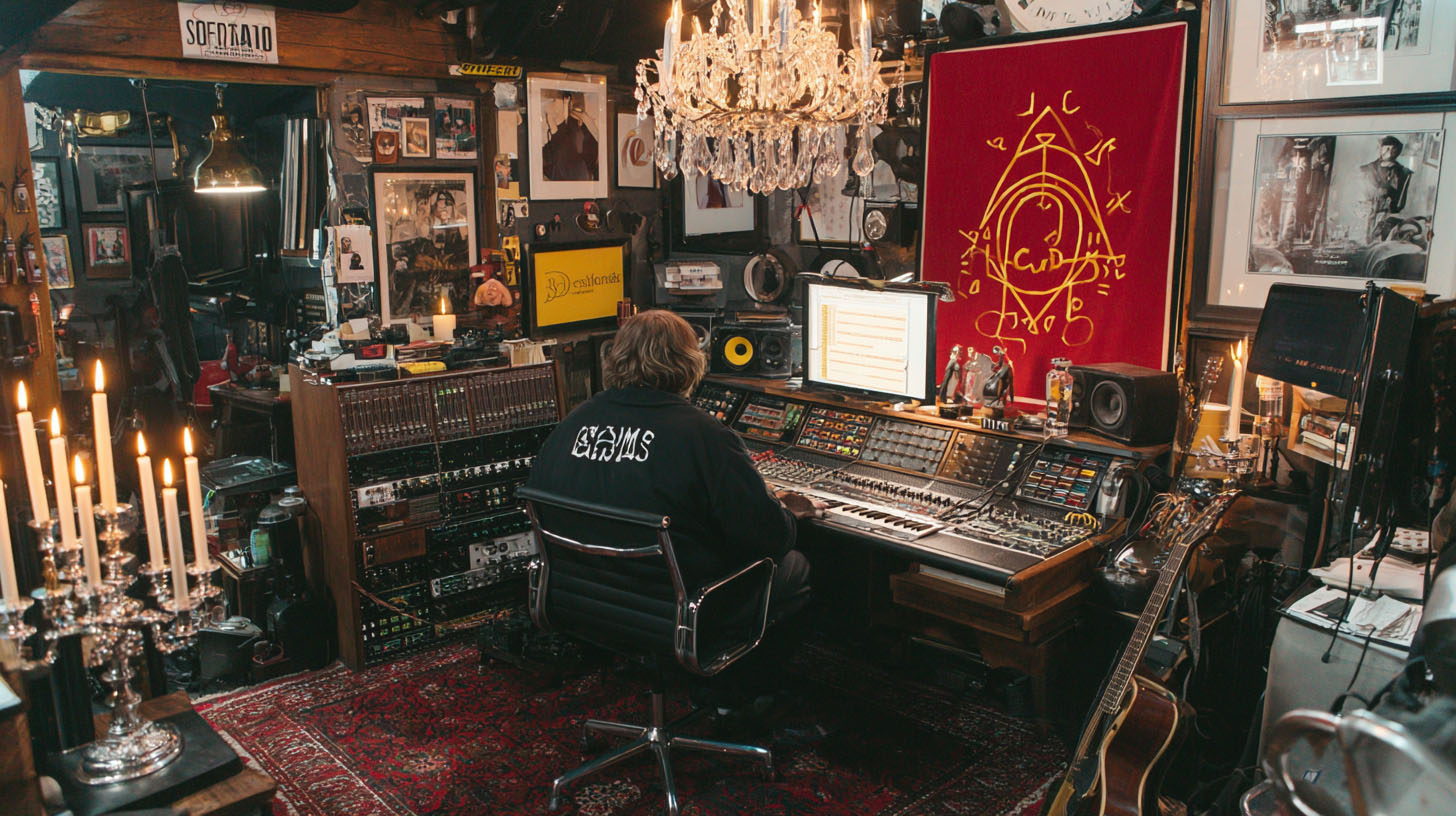
How Animals As Leaders are redefining modern metal guitar
Nail The Mix Staff
When you hear Animals As Leaders, you know it. That mind-bending blend of insane technicality, complex rhythms, and surprisingly beautiful melodies is instantly recognizable. Tosin Abasi and Javier Reyes aren't just guitarists; they're sonic architects pushing the boundaries of what's possible on extended-range instruments. But what makes their sound so impactful, especially from a production standpoint? It's more than just fancy guitars and complex riffs.
The AAL Ethos: Precision is King (Not Just Gear)
Yeah, the gear AAL uses is top-notch (we'll get to that), but if you think that's the only reason they sound so colossal, you're missing the bigger picture. We're living in an era where guitarists are reaching insane levels of precision and creativity, and AAL are poster children for this. It’s a fundamental shift: a deep, almost obsessive focus on rhythmic accuracy and impeccable musicianship before a single plugin is loaded. This isn't about using gear as a crutch; it's about using it as an extension of already rock-solid skills.
Rhythmic Alchemy: The Bedrock of AAL
Listen to any AAL track – 'CAFO,' 'The Woven Web,' 'Monomyth.' What underpins all the mind-melting leads and sophisticated harmony? God-tier rhythmic precision. We're talking polyrhythms, odd-time signatures, and syncopation that would make a metronome sweat, all executed with surgical accuracy. Every hit is intentional, every subdivision felt. This isn't just playing fast; it's an almost telepathic connection between the players, where every triplet, eighth note, and 16th note is executed flawlessly. This level of tightness is the absolute foundation of their powerful sound.
Why This Tightness Makes Your Mix Life Easier
This obsession with rhythmic integrity isn't just for show. As producers, we know: tight performances are a dream. When guitars are locked in like AAL's, they stack beautifully. You get that massive, clear 'wall of sound' without it collapsing into a muddy, chaotic mess. Editing becomes minimal; you're enhancing, not trying to fix something that's fundamentally broken. Your DI tracks are pure gold, translating into articulate and powerful reamps that require less corrective EQ and respond predictably to compression.
Crafting the AAL Guitar Tone: Tools for Titans
Okay, so they're incredible players. But what gear helps them translate that skill into their signature tones? It's a combination of forward-thinking instrument design, versatile amp modeling, and tasteful effects, all serving the music.
Abasi Concepts: Guitars Built for Modern Gods
You can't talk AAL without mentioning Tosin Abasi's own Abasi Concepts guitars. These aren't your grandpa's six-strings. We're talking 8-string beasts, often with fanned frets for optimal string tension and ergonomics, allowing for those subterranean lows and screaming highs. Pickups like Fishman Fluences are common, offering versatile voicings perfect for their dynamic range – from crystal cleans to brutal distortion. These instruments are purpose-built for the kind of extended techniques Tosin and Javier employ, like thumping, selective picking, and intricate fingerstyle passages.
The Digital Brain: Fractal Audio Axe-Fx Dominance
For years, AAL has been synonymous with Fractal Audio systems, particularly the Axe-Fx series (currently the Axe-Fx III). Why? Unparalleled flexibility and consistency. They can dial in everything from pristine cleans to searing high-gain leads and everything in between, all recallable at a stomp. Popular amp models you'd use to get in their ballpark might include:
- Friedman BE/HBE: For that articulate, aggressive, yet clear high-gain rhythm and lead tone.
- Mesa Boogie Rectifier Models: For some of the heavier, chunkier tones, offering that classic tight low-end.
- EVH 5150/Peavey 6505 Models: Classic metal high-gain, great for aggressive parts that need to cut.
- Fender-style Cleans (e.g., Deluxe Reverb, Twin Reverb): For their more melodic and ambient sections, providing a clean palette.
The key is starting with a DI signal that’s clear, punchy, and incredibly well-played. The Axe-Fx then shapes this into a myriad of tones.
FX Wizardry: Delays, Reverbs, and Beyond
AAL’s soundscapes are often augmented with carefully chosen effects. Think lush stereo delays (often from the Axe-Fx itself, capable of U2-esque rhythmic patterns but applied with far more complexity), spacious reverbs (like Eventide Blackhole or Strymon BigSky emulations), and occasional pitch-shifting (like a DigiTech Whammy or similar emulations within the Axe-Fx). The crucial part? These effects enhance the playing; they don't cover up flaws. They add depth and atmosphere to already stellar performances, often programmed to interact rhythmically with the parts.
Mixing Animals As Leaders: Sculpting the Complexity
So you've got these incredibly tight, dynamically rich guitar tracks. How do you approach mixing them to ensure every nuance cuts through and the whole thing sounds massive?
The Foundation: Pristine DI Tracks
It all starts with those DI signals. If the DIs are tight, clear, and have a good dynamic range with consistent attack, your job as a mix engineer is already 50% easier. AAL's DIs are likely impeccable, making re-amping or amp sim processing (like using Neural DSP plugins or the Axe-Fx itself in the box) a joy rather than a rescue mission.
EQing for Separation and Impact
With multiple guitars playing complex, often intertwining parts, EQ is critical. You're not just scooping mids here; it’s about surgical precision.
- Low-End Management: With 8-strings, managing the low-end is crucial. High-pass filtering judiciously (maybe around 80-100Hz, or even higher depending on the part and bass guitar) to avoid clashing with the bass, but retaining the weight.
- Mid-Range Carving: Each guitar needs its own space in the mids. Think complementary EQ boosts and cuts on different guitar tracks to help them sit together. A common area to clean up mud is between 200-500Hz. For more on this, check out our EQ strategies for mixing modern metal hub.
- Taming Fizz: Like any high-gain tone, you'll likely need to surgically cut any harsh, fizzy top-end (often lurking between 5kHz-10kHz, sometimes even higher) with a narrow Q on an EQ like FabFilter Pro-Q 3 to keep things smooth without losing aggression.
- High-End Air: A gentle boost in the 'air' frequencies (12kHz+) can add clarity and presence to intricate lines, helping them float above the mix.
Strategic Compression for Punch and Control
AAL's playing is incredibly dynamic. Compression needs to be applied thoughtfully, not just slammed.
- Peak Control: Light compression (e.g., an 1176-style FET compressor with a fast attack and release, aiming for a few dB of gain reduction) to catch stray peaks and even out the performance, especially on percussive 'thumped' parts.
- Enhancing Attack: A slower attack on your compressor (e.g., 20-30ms) can let the initial transient through, enhancing the percussive nature of their playing before the compression kicks in.
- Bus Compression: Gentle compression (e.g., an SSL-style VCA bus compressor with a ratio of 2:1 or 4:1, slow attack, fast release, just tickling 1-2dB of GR) on a guitar bus can help 'glue' the parts together and provide a more cohesive sound. Dive deeper into metal compression secrets beyond just making it loud.
Don't squash the life out of it; use compression to control and enhance the natural dynamics.
Panning for Width and Clarity
Strategic panning is essential. With two guitarists often playing distinct but complementary parts, panning them wide (e.g., one guitar 70-100% Left, the other 70-100% Right) can create a massive stereo image and give each part its own sonic space. This allows the listener to better discern the intricate interplay and avoids a cluttered center.
Your Turn: Applying AAL's Precision to Your Music
Inspired? You should be! While reaching AAL's level is a monumental task, the principles behind their sound are applicable to any modern metal producer. The bar for musicianship has skyrocketed, largely thanks to the internet and the accessibility of learning resources.
Your DAW: The Ultimate Practice Partner
Your DAW (Pro Tools, Reaper, Cubase, Logic, whatever you use) is one of the most powerful practice tools you own. Don't just record songs; record your practice.
- Pick a Riff: Something you think you play well.
- Record to a Click: Non-negotiable! Use a click sound you can clearly hear and deliberately lock in with.
- Analyze Brutally: Zoom in on those waveforms. Where are your transients hitting relative to the grid? Don't just listen back and say "sounds okay." Look at the visual evidence. Be honest. This isn't to beat yourself up; it's to get crucial feedback and identify specific weaknesses to target. Do this regularly, even with scales or exercises.

100+ Insanely Detailed Mixing Tutorials
We leave absolutely nothing out, showing you every single step
Musicianship Before Plugins
It’s tempting to chase tone with a new plugin, modeler, or guitar. But remember, a $3000 Axe-Fx won’t fix sloppy 16th notes. Focus on your attack, your consistency, your rhythmic placement. These are huge components of your modern heavy metal guitar sound before any gear gets involved. Is your playing worthy of that high-end gear?
Embrace New Techniques & Online Learning
The internet has made learning advanced techniques more accessible than ever. Explore hybrid picking, fingerstyle, thumping, or even concepts from other genres like flamenco that players like Tim Henson (Polyphia) or AAL incorporate. Sites like YouTube and dedicated platforms (shameless plug: Riffhard for guitarists!) offer incredible resources that used to require geographically blessed access to great teachers.
Ready to Mix Like the Pros? Nail The Mix Has Your Back.
Mastering rhythmic precision and dialing in those complex tones is a journey. But what if you could learn directly from the producers who mix bands like Periphery, Meshuggah, and Gojira – bands that share that same DNA of technicality and precision as Animals As Leaders?
That’s exactly what Nail The Mix offers. Every month, you get the actual multi-tracks from a killer metal song and watch the original producer mix it from scratch, explaining every EQ move, every compression setting, every decision they make. It's about seeing how to enhance already great performances and build truly massive, clear, and powerful mixes. If you're serious about taking your metal productions to the next level and want to unlock your sound beyond presets, this is where it happens. Stop blaming gear or tuning; the power to get ridiculously great is out there. Focus on that rhythmic precision and use technology to your advantage, and you'll be amazed how far you can go.
Get a new set of multi-tracks every month from a world-class artist, a livestream with the producer who mixed it, 100+ tutorials, our exclusive plugins and more
Get Started for $1





